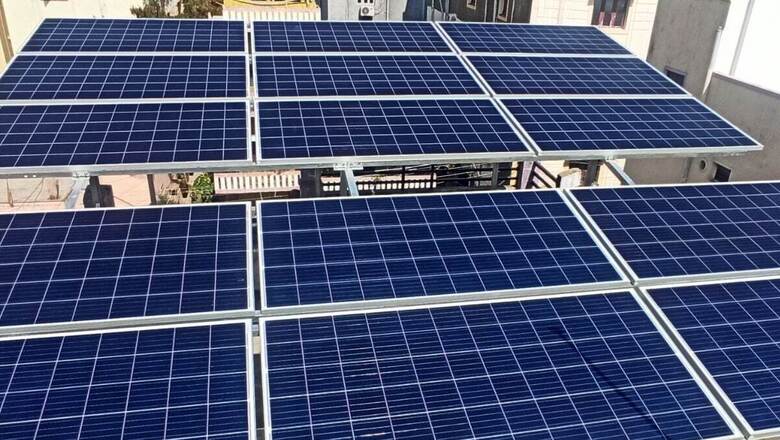
views
Following the grand inauguration of the Ram Janmabhoomi Mandir in Ayodhya on January 22, Prime Minister Narendra Modi announced the decision to launch a scheme — Pradhan Mantri Suryodaya Yojana — with the target of installing rooftop solar panels on one crore homes.
Over the years, the Modi-led central government has laid tremendous emphasis on enhancing solar energy capacity and a core part of that strategy is the installation of rooftop solar panels whose total capacity has skyrocketed from 1.8 GW in 2019 to more than 10.4 GW in 2024 as of today.
“The first decision I have taken after returning from Ayodhya is that our government will launch Pradhan Mantri Suryodaya Yojana with the target of installing rooftop solar panels on 1 crore houses,” said the prime minister.
“This will not only reduce the electricity bill of the poor and middle classes, but will also make India self-reliant in the energy sector,” he added.
The initiative will prove to be a shot in the arm for India’s solar energy sector, which has amped up domestic manufacturing capacity and will significantly complement the Centre’s purported goal to embark on a journey towards ensuring 24-hour power supply throughout India by March 2025.
This solar scheme, coupled with others dedicated to enhancing access to electricity, like Saubhagya and Deen Dayal Upadhyaya Gram Jyoti Yojana (DDUGJY), is a testament to the Modi-led government’s commitment to ensure electricity access to Indians across the board.
It will also bolster India’s leadership at the International Solar Alliance, an initiative founded and headquartered in India and joined by 121 nations, as it shall globally portray the immense potential of solar energy when it comes to empowering the poor and may emerge as a model for several nations, particularly Africa and Asia.
Harvesting rooftop rays
While India is home to some of the world’s largest solar parks, the country crossed an addition of 4 GW of rooftop solar capacity in 2023 alone and had been projected to add another 4 GW in the next two years. The prime minister’s latest impetus involving solar installations in one crore homes could increase that capacity.
By the end of 2023, the cumulative installed capacity in the rooftop solar segment in the country has surpassed 10 GW. Gujarat has emerged as the frontrunner in this segment, making a significant contribution of 30 percent to the total capacity. The rooftop solar installed capacity has witnessed substantial growth, escalating from 1.8 GW as of March 31, 2019, to the current 10.4 GW.
The government’s rooftop solar programme is geared towards the residential sector, aiming to democratise solar energy access through subsidies. With a specific focus on installing solar panels on rooftops, the programme seeks to empower households to embrace sustainable energy solutions. This is not just a means to achieving India’s green energy goals, but also a sustainable solution for the rising energy demand in households, curbing electricity expenses.
Further, an off-grid solar PV applications programme is being designed for rural areas with the goal of providing accessible solar energy through subsidies. Its primary focus lies in implementing off-grid solar PV applications for decentralised power generation, ensuring that remote communities can benefit from sustainable and independent energy solutions.
This, coupled with the rooftop solar programme, has made a phenomenal impact in rural areas. Rooftop solar installations have led to a reduction in the burden on rural women and girls, as it eliminates the need for long-distance fuel wood collection. This not only alleviates drudgery but also mitigates health risks linked to lung and eye ailments. Additionally, the programme generates employment at the village level, contributing to an overall improvement in the standard of living.
Soaking in solar success
India is basking in solar success, boasting an installed capacity of approximately 70.10 gigawatts as of June 30, 2023. At present, solar power accounts for about 38 percent of the total renewable energy capacity. Surging from 21 GW to an impressive 70 GW in the last five years, India now stands as the world’s fourth-largest solar power player. With an ambitious goal of hitting 500 GW in renewable energy capacity by 2030, the sun seems to be shining brightly on India’s clean energy aspirations.
As India is abundantly blessed with sunlight, solar energy has been an integral component of the larger strategy for renewable energy capacity. The country possesses an abundant solar energy potential, with approximately 5,000 trillion kilowatt-hours (kWh) of solar energy incident over its land area each year. In many regions of the country, there is an average daily receipt of 4-7 kWh per square metre.
Further, India typically experiences about 300 clear and sunny days in a year, providing a conducive environment for harnessing solar power. This wealth of solar resources underscores the significant opportunity for India to expand its solar energy capacity and contribute to a more sustainable and clean energy future.
Manufacturing for solar
The addition of solar panels across one crore more homes under the Pradhan Mantri Suryodaya Yojana will significantly boost local manufacturers witnessing a business boom owing primarily to the government’s push for self-reliance or ‘atmanirbharta’.
In recent years, the Centre has implemented a series of measures aimed at not only increasing the proportion of solar power in the country’s energy mix but also significantly enhancing India’s presence in the global solar manufacturing sector. The government has resorted to quick fixes as well as long term solutions to activate and energise this sector.
A pivotal move that has greatly been of benefit to the manufacturing sector is the government’s choice to levy a 40 percent basic customs duty on solar modules and a 25 percent duty on solar cells. This opened up a much-needed window for domestic manufacturers to scale up production capacity in alignment with rising local and international demand.
Further providing impetus to the sector, the government has initiated a production-linked incentive scheme (PLI) to boost self-reliance in the solar manufacturing sector and diversify supply chains away from China. The government’s initial PLI for solar manufacturers stands strong with a total outlay of Rs 14,007 crore.
Under PLI (tranche-I), an integrated capacity of 8.737 GW has been added. In the realm of solar PV manufacturing projects, 11 companies, including Indosol, Reliance Industries, Tata Power Solar, and ReNew and First Solar, have secured projects totalling 39.6 GW capacity.
This is part of the PLI scheme for high-efficiency solar PV modules (tranche-II). Breaking down the allocated capacity, 39.6 GW of domestic solar PV module manufacturing capacity has been assigned. The operational timeline anticipates 7.4 GW to be operational by October 2024, with a target of 16.8 GW for April 2025. The remaining 15.4 GW capacity is set for operationalisation by April 2026.
In the first half of 2023, India is reported to have slashed its solar module imports from China by almost 80 percent, marking a $2 billion reduction, while simultaneously invigorating its domestic manufacturing capacity which is poised for a boom.
As global momentum towards reducing reliance on fossil fuels to combat climate change gains traction, India’s solar energy sector is gaining international recognition. A report by Wood Mackenzie predicts that by 2025, India will become the world’s second-largest producer of solar modules, challenging China’s dominance. While China holds an 80 percent share in the global solar module supply chain, India is making strides in breaking this monopoly.
Notably, India’s solar manufacturing capacity is gearing towards meeting the demand from the US, which already constitutes nearly 93 percent of India’s solar PV exports. This shift signifies promising developments in India’s solar industry.




















Comments
0 comment